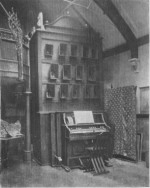
In 1763, Castel published perhaps his best general theory of color-music in Esprits Saillies et Singularites du Pere Castel. “Can one imagine anything in the arts which would surpass the visible rendering of sound, which would enable the eyes to partake of all the pleasures which music gives to the ears?
“What could we say of an art which did not only simply awaken the idea of speech, and of sound, by means of arbitrary and inanimate characters, such as the letters of the alphabet, or the notes of music; but painted it really; that is painted it with colors; in one word, rendered it felt and present to the eyes, as it is to the ears, in such a manner that a deaf person can enjoy and judge the beauty of music as well as he who can hear.” Let us look at the place of music amongst the arts.
A. Wallace Rimington said, “if we look at the matter dispassionately, I think we shall come to the conclusion that the whole use and influence of music rests upon its power of stimulating emotional faculties. Whether the emotions aroused by it are identical with those of our ordinary life and experience, or whether, as some philosophic writers think, they are of a somewhat different and special kind, belonging, as it were, to a higher plane of feeling… the fact remains that music interests, refreshes, invigorates, saddens, or makes us glad through its action upon the emotional side of our nature, and is a language without words.
 “The action that color has upon us in its harmonies and contrasts, its varying strength and delicacy, its power of giving joy or pain, is also to a large extent, an emotional one. Color is precious for its own sake and as an educative influence. It also can stimulate the imagination and develop other mental faculties; can give refreshment to the mind, and increase the responsiveness of the sense to which it appeals. So let us then clear our own path through the jungle of untried possibilities, which prevents our seeing clearly how to use the attributes of color in a mobile color art somewhat resembling music.”
“The action that color has upon us in its harmonies and contrasts, its varying strength and delicacy, its power of giving joy or pain, is also to a large extent, an emotional one. Color is precious for its own sake and as an educative influence. It also can stimulate the imagination and develop other mental faculties; can give refreshment to the mind, and increase the responsiveness of the sense to which it appeals. So let us then clear our own path through the jungle of untried possibilities, which prevents our seeing clearly how to use the attributes of color in a mobile color art somewhat resembling music.”
In the 1920s several individuals developed color music devices. They created beautiful devices that looked very similar to organs and as they played their keyboards beautiful combinations and harmonies of color were projected through the audience. The two best books for reference on the subject are; Colour-Music: The Art of Mobile Colour (1911), W. Rimington; Colour-Music: The Art of Light (1926), by A. B. Klein
